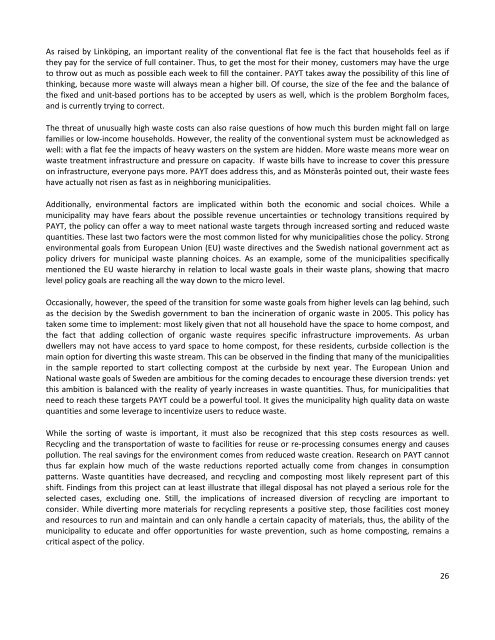Waste prevention and Pay as You Throw, a collective case ... - lumes
Waste prevention and Pay as You Throw, a collective case ... - lumes
Waste prevention and Pay as You Throw, a collective case ... - lumes
Create successful ePaper yourself
Turn your PDF publications into a flip-book with our unique Google optimized e-Paper software.
As raised by Linköping, an important reality of the conventional flat fee is the fact that households feel <strong>as</strong> if<br />
they pay for the service of full container. Thus, to get the most for their money, customers may have the urge<br />
to throw out <strong>as</strong> much <strong>as</strong> possible each week to fill the container. PAYT takes away the possibility of this line of<br />
thinking, because more w<strong>as</strong>te will always mean a higher bill. Of course, the size of the fee <strong>and</strong> the balance of<br />
the fixed <strong>and</strong> unit‐b<strong>as</strong>ed portions h<strong>as</strong> to be accepted by users <strong>as</strong> well, which is the problem Borgholm faces,<br />
<strong>and</strong> is currently trying to correct.<br />
The threat of unusually high w<strong>as</strong>te costs can also raise questions of how much this burden might fall on large<br />
families or low‐income households. However, the reality of the conventional system must be acknowledged <strong>as</strong><br />
well: with a flat fee the impacts of heavy w<strong>as</strong>ters on the system are hidden. More w<strong>as</strong>te means more wear on<br />
w<strong>as</strong>te treatment infr<strong>as</strong>tructure <strong>and</strong> pressure on capacity. If w<strong>as</strong>te bills have to incre<strong>as</strong>e to cover this pressure<br />
on infr<strong>as</strong>tructure, everyone pays more. PAYT does address this, <strong>and</strong> <strong>as</strong> Mönsterås pointed out, their w<strong>as</strong>te fees<br />
have actually not risen <strong>as</strong> f<strong>as</strong>t <strong>as</strong> in neighboring municipalities.<br />
Additionally, environmental factors are implicated within both the economic <strong>and</strong> social choices. While a<br />
municipality may have fears about the possible revenue uncertainties or technology transitions required by<br />
PAYT, the policy can offer a way to meet national w<strong>as</strong>te targets through incre<strong>as</strong>ed sorting <strong>and</strong> reduced w<strong>as</strong>te<br />
quantities. These l<strong>as</strong>t two factors were the most common listed for why municipalities chose the policy. Strong<br />
environmental goals from European Union (EU) w<strong>as</strong>te directives <strong>and</strong> the Swedish national government act <strong>as</strong><br />
policy drivers for municipal w<strong>as</strong>te planning choices. As an example, some of the municipalities specifically<br />
mentioned the EU w<strong>as</strong>te hierarchy in relation to local w<strong>as</strong>te goals in their w<strong>as</strong>te plans, showing that macro<br />
level policy goals are reaching all the way down to the micro level.<br />
Occ<strong>as</strong>ionally, however, the speed of the transition for some w<strong>as</strong>te goals from higher levels can lag behind, such<br />
<strong>as</strong> the decision by the Swedish government to ban the incineration of organic w<strong>as</strong>te in 2005. This policy h<strong>as</strong><br />
taken some time to implement: most likely given that not all household have the space to home compost, <strong>and</strong><br />
the fact that adding collection of organic w<strong>as</strong>te requires specific infr<strong>as</strong>tructure improvements. As urban<br />
dwellers may not have access to yard space to home compost, for these residents, curbside collection is the<br />
main option for diverting this w<strong>as</strong>te stream. This can be observed in the finding that many of the municipalities<br />
in the sample reported to start collecting compost at the curbside by next year. The European Union <strong>and</strong><br />
National w<strong>as</strong>te goals of Sweden are ambitious for the coming decades to encourage these diversion trends: yet<br />
this ambition is balanced with the reality of yearly incre<strong>as</strong>es in w<strong>as</strong>te quantities. Thus, for municipalities that<br />
need to reach these targets PAYT could be a powerful tool. It gives the municipality high quality data on w<strong>as</strong>te<br />
quantities <strong>and</strong> some leverage to incentivize users to reduce w<strong>as</strong>te.<br />
While the sorting of w<strong>as</strong>te is important, it must also be recognized that this step costs resources <strong>as</strong> well.<br />
Recycling <strong>and</strong> the transportation of w<strong>as</strong>te to facilities for reuse or re‐processing consumes energy <strong>and</strong> causes<br />
pollution. The real savings for the environment comes from reduced w<strong>as</strong>te creation. Research on PAYT cannot<br />
thus far explain how much of the w<strong>as</strong>te reductions reported actually come from changes in consumption<br />
patterns. <strong>W<strong>as</strong>te</strong> quantities have decre<strong>as</strong>ed, <strong>and</strong> recycling <strong>and</strong> composting most likely represent part of this<br />
shift. Findings from this project can at le<strong>as</strong>t illustrate that illegal disposal h<strong>as</strong> not played a serious role for the<br />
selected c<strong>as</strong>es, excluding one. Still, the implications of incre<strong>as</strong>ed diversion of recycling are important to<br />
consider. While diverting more materials for recycling represents a positive step, those facilities cost money<br />
<strong>and</strong> resources to run <strong>and</strong> maintain <strong>and</strong> can only h<strong>and</strong>le a certain capacity of materials, thus, the ability of the<br />
municipality to educate <strong>and</strong> offer opportunities for w<strong>as</strong>te <strong>prevention</strong>, such <strong>as</strong> home composting, remains a<br />
critical <strong>as</strong>pect of the policy.<br />
26
















